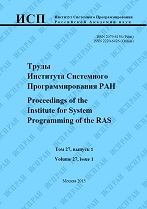|
This article is cited in 1 scientific paper (total in 1 paper)
The numerical solution of the problem of stratified fluid flow around a wedge using OpenFOAM
N. F. Dimitrieva
Institute of Hydromechanics of the National Academy of Sciences of Ukraine
Abstract:
Based on the open source software 2D numerical simulations of incompressible stratified fluids flows have been performed. They are characterized by a wide range of values of internal scales that are not in a homogeneous liquid. Mathematical model is based on the fundamental set of differential equations of inhomogeneous multicomponent fluid mechanics. The problem is solved using the finite volume method in an open source package OpenFOAM. The method allows analyzing in a single formulation the dynamics and fine structure of flow patterns past obstacles in a wide range of flow parameters. A particular attention is focused at construction of a high quality computational grid which satisfies basic requirements for resolution of all the microscales of the problem in high-gradient regions of the flow. The calculations were performed in parallel regime on computational facilities of the web-laboratory UniHUB (www.unihub.ru). The same system of equations and a general numerical algorithm were used for the whole range of the parameters under consideration. The calculation results are in a qualitative agreement with the data from laboratory experiments. Transient flow patterns past obstacles are analyzed, and physical mechanisms are determined, which are responsible for formation of vortices in regions with high density gradients near the edges of an obstacle. For all the velocities of the body motion, the flow field is characterized by a complicated internal structure. In the flow pattern around motionless body dissipative gravity waves are manifested at the edges of the strip. Around the slowly moving body a group of attached waves, are formed in opposite phases at the edges of the wedge. Then, the main flow components become vortices, which are formed around the edge of the wedge and manifested downstream in the wake. With further increase in velocity of the body motion, the flow pattern becomes more non-stationary.
Keywords:
numerical simulation, open source computational packages, stratified flows.
Citation:
N. F. Dimitrieva, “The numerical solution of the problem of stratified fluid flow around a wedge using OpenFOAM”, Proceedings of ISP RAS, 29:1 (2017), 7–20
Linking options:
https://www.mathnet.ru/eng/tisp97 https://www.mathnet.ru/eng/tisp/v29/i1/p7
|

| Statistics & downloads: |
| Abstract page: | 258 | | Full-text PDF : | 113 | | References: | 42 |
|




 Contact us:
Contact us: Terms of Use
Terms of Use
 Registration to the website
Registration to the website Logotypes
Logotypes







 Citation in format
Citation in format 
